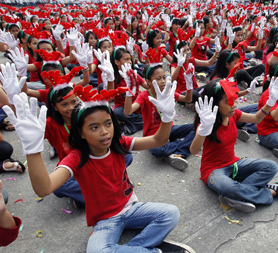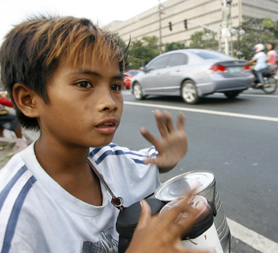No happy Christmas for Manila’s children carol singers
Children come from all over the Philippines to sing carols in Manila in the run-up to Christmas, as a way to get money for food. But now the practice has been banned, as John Sparks writes.
There is no shortage of festive cheer in Manila, the fast-expanding capital of the Philippines. In this largely Catholic nation of 7,000 islands in the South China Sea, Christmas is a participatory event.
The thoroughfares of this megacity of 20 million are almost permanently clogged, as rich and poor make their way to mass or Christmas parties or the malls to do their shopping.
And it is here that Manila’s citizens meet, greet and stare at each other – for there is no other way to get around. The streets don’t’just serve the motorists – they are far more multi-functional than that. The roads and alleyways provide a rough and ready home for hundreds of thousands, who make beds from cardboard and move on at dawn.
Street children
Their number include tens of thousands of street children – some with families but many without. Nobody is sure how many street kids there are. The Philippines Government told us 25,000 eke out an existence here – but children’s welfare groups say the number is much higher – more than 100,000, they claim.
It seems an extraordinary number, but it ceases to shock a few hours after arrival, for Manila is a city of children. You don’t have to go far to see them, dodging and weaving around the traffic, and the Christmas season presents them with a very special opportunity.
Equipped with homemade drums and bottle-caps on wires, the street kids go carolling car door to car door, singing festive songs to their better-off brethren with wheels. The hope, of course, that the vehicle’s occupants are feeling generous and toss out a few coins.

Hunger pangs
We spent one evening watching the kids at work. I asked our Filipino producer to translate the words to one of these songs. Not surprisingly perhaps, it was all about filling one’s belly. It goes a bit like this: “The night was so delightful. My sister cooks some food for us at my brother’s house. We eat pig on a spit. Yes, come on, let’s celebrate. We can all eat bread and cheese for then tomorrow it will be Christmas Day.”
This song says a lot. If you have to sing songs in the middle of the street to make money, they might was well be about eating food.
I spoke to two youngsters, Mark Arevalo and Mark Guttieres, who told me they were best friends. Speaking in unison, they simply said, “We want money to buy food. We want to eat more and feel full.”
Carols banned
Problem is, the Filipino and City of Manila governments don’t want the kids carolling on the streets. In fact, they banned the practice altogether. It hasn’t gone down well. Kids start in October and they come from all over the Philippines to do it, often because they are hungry or following the orders of their parents.
I met the woman responsible for the prohibition, Corazon Juliano Soliman, from the Department of Social Welfare and Development, who told me: “We have banned that because you risk the children being run over, and there have been children who’ve been run over. You put them in greater danger of inhaling all the pollutants in the air. Their parents must be the ones to make sure they have food on the table, not the children.”

Rescue squads
The kids keep a constant eye out for the cops and anybody else who looks “official”. A number of youngsters told us they were desperate to avoid encounters with one of Manila’s “rescue squads”, teams of government employees assigned to get them off the streets and into one of the government’s notorious “Reception and Action Centres.”
Children’s welfare campaigners told us these rescue squads operate under government quotas to get the kids out of public areas. Little thought is given to their longer-term future, says Catherine Scerri, who founded children’s charity Bayah Tuluyan.
Many children reported being incredibly scared during the rescue process. Catherine Scerri, of charity Bayah Tuluyan
She told us that these rescue teams often use unacceptable methods to scoop up the kids.
“Many children reported being incredibly scared during the rescue process, and some of them quite badly hurt as well. They often had batons used against them. They said that police, officials or rescuers had guns, used handcuffs, put them in vans, locked them.”
Critics say the rescue teams would better be described as “snatch squads” – the kids are arrested and detained for being homeless, they say. The government’s reception centres, where the children are meant to assisted and evaluated before being sent on to more appropriate accommodation, are also criticised by many here.
Living in cells
We were given a tour of Manila’s street children reception centre. Boys from one to 18 are crowded into one cell, the girls in another. We were only able to film from the outside. Bullying and abuse is rampant here, we were told. The mentally and physically disabled are also dumped here – and largely ignored.
The woman in charge of the centres, Corazon Juliano Soliman, said: “The conditions of the centres are not good enough. We need to upgrade the skills of the staff and have more professional handling. In fact, I know of cases where the children have been molested and that I think is unacceptable.”
The Verlanie Foundation is one of several charities that take on former street children from the government’s reception centres, like the one we saw. Charlotte and her brother Arvin are glad to be here. Charlotte told us: “We’re very happy here.”
Arvin said: “They used to beat us at the reception centre, but our lives are much better now.”
There’s lots of laughter – childhood resumed. A happy Christmas awaits. Yet many thousands on the streets of Manila won’t be so fortunate.
-
Latest news
-
‘Government responsiveness should be improved’ says infected blood inquiry chair4m

-
Infected Blood scandal: How UK failed on a global scale4m

-
‘There’s a strong evidential basis’ for ICC to grant arrest warrants for Netanyahu, says criminal law expert4m

-
International Criminal Court prosecutor seeks arrest warrants for Israel PM and Hamas leaders3m

-
‘Highly unlikely there was foul play’ in Iran president helicopter crash, says Tehran professor5m

-




